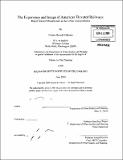The experience and image of American elevated railways : rapid transit infrastructure in the urban consciousness
Author(s)
Hansen, Gordon Benedict
DownloadFull printable version (76.91Mb)
Alternative title
Rapid transit infrastructure in the urban consciousness
Other Contributors
Massachusetts Institute of Technology. Dept. of Urban Studies and Planning.
Advisor
Sam Bass Warner.
Terms of use
Metadata
Show full item recordAbstract
At the turn of the twentieth century, elevated railways were built out of a practical need to literally "elevate" traffic above the street. In most cases, these lines served two distinct purposes. They served existing neighborhoods with reliable and rapid access to the center of the city. In addition, they made feasible the creation of new communities that enhanced growth of the city itself. Built out of steel, iron, and sometimes concrete, these lines were utilitarian but often employed distinctive, architecturally significant station and structure designs. Although the negative effects were universal -- Els were noisy, blocked sunlight, and contributed to urban decay -- due to local context, response to the elevated lines in Boston, Chicago and Philadelphia differed among those who used, maintained, and lived by the line. For some, the line was a backbone of community commerce or memory; for others, the line was a very present symbol of political incompetence or apathy. In Boston especially, collective memory of these structures is continually evolving in online communities, the El's legacy heightened among transit enthusiasts. In other cities, such as Philadelphia and Chicago, the transit agency's reliance on these elevated lines has led to recent pushes for reconstruction, transit-oriented-development and community reinvestment. In these latter two cities, recent El-related projects indicate that city planners and transit officials have renewed hope in the vitality and capacity of elevated rail transport; and recent station renovations have acted in kind, emphasizing as much as possible light, celebratory historical architecture, and universal access. (cont.) Furthermore, even as cities work to modernize elevated (now "aerial") structures, new lines are being constructed around the world as cost-effective modes of urban transportation. The aim of the thesis is twofold. First, the three city chapters offer a cohesive historical narrative of neighborhood responses to the elevated lines that served them. The goal is to illustrate the diverse array of impacts, meanings, reactions and responses that have emerged from the past. The second goal is to underscore that elevated rapid transit structures have more value in the urban consciousness than simply as a means of travel. Because they have, in the past, come to represent the communities they served, whether on a local, city-wide, or national level, planners must understand that elevated transit lines will continue to be imbued with meaning. Therefore, planners must internalize this relationship between image and actuality, and institute a new step in future elevated transit line renovations. A meeting should be held incorporating community groups, local institutions, and private individuals, to better understand the elevated transit line. Planners and designers would use this information to coordinate how local history, culture and artwork could direct station and structure design.
Description
Thesis (M.C.P.)--Massachusetts Institute of Technology, Dept. of Urban Studies and Planning, 2009. Includes bibliographical references (leaves 106-114).
Date issued
2009Department
Massachusetts Institute of Technology. Department of Urban Studies and PlanningPublisher
Massachusetts Institute of Technology
Keywords
Urban Studies and Planning.